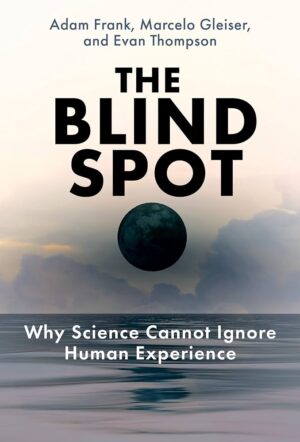The following is an excerpt is from the book The Blind Spot by Adam Frank, Marcelo Gleiser, and Evan Thompson.
Watch our CTT Chat with theoretical physicist and astronomer Marcelo Glesier here.
From Chapter 1
The Blind Spot worldview is like the air—invisible but all around us. We’re given simple versions of it in high school science classes, and we find it as an unspoken background assumption in science documentaries. If you pursue a career in science, it often lies like an invisible map marking your journey through introductory classes in physics, chemistry, and biology. Although there have been sophisticated philosophical articulations of the ideas that make up what we call the Blind Spot worldview, for most people, including most scientists, it’s so pervasive that it doesn’t seem like philosophy at all. Rather, people think it’s just “what science says.”
In truth, however, it’s not what science says. Instead, it’s an optional metaphysics attached to, but separable from, the actual practice of science. There are other and better ways to understand the relationship between science and the world. In the development of the modern scientific worldview, which the German mathematician and philosopher Husserl regards as beginning with Galileo, the abstract and idealized representation of nature in mathematical physics is covertly substituted for the concrete real world, the world that we perceive. The perceptual world is demoted to the status of mere subjective appearance, while the universe of mathematical physics is promoted to the status of objective reality. Thus, according to this way of thinking, temperature or the average kinetic energy of atoms or molecules is what’s objectively real, but the feelings of hot and cold are mere subjective appearances.
Husserl argues that the “surreptitious substitution” is unjustified because it’s based on a fundamental misunderstanding of mathematical physics. Physical laws specify, in mathematical terms, how things behave in idealized situations. For example, Galileo’s law of free-falling bodies states that in the idealized case of the absence of air resistance, all bodies fall with the same acceleration independent of their mass. Galileo showed mathematically and experimentally that the distance a free-falling body travels is directly proportional to the square of the time it takes to fall. Similarly, the ideal gas law, also known as the general gas equation, states the relation between the pressure, volume, and temperature of an ideal gas. In this equation, the molecules do not attract or repel each other or take up any volume. The molecules are instead represented as geometrical points called “ideal structureless particles.”
We can see from these examples that the laws of mathematical physics refer to idealized objects and their properties—free-falling bodies, friction- less planes, hypothetical ideal gases, perfectly elastic collisions, and so on. These idealized objects and properties aren’t physically real. They don’t actually exist in space and time, and they don’t participate in causal interactions. So they do not and cannot constitute the real world of nature. They’re fictional entities that we use as tools. They’re conceptual instruments necessary for us to formulate exact mathematical statements that we can apply to the real world through a series of increasingly accurate approximations. This is how we gain predictive knowledge of things and control over them.
Mathematical idealization and approximation constitute a method for knowing how things will behave under various conditions. But the method doesn’t tell us what things are and why they behave as they do. Hence, to think that the idealized laws of mathematical physics describe the inherent being of nature is fundamentally mistaken. To think this way is to confuse the map—an idealized and limited representation of the terrain— with the territory. As Husserl says, to think this way is to “take for true being what is actually a method.” This is the surreptitious substitution—the substitution of a tool to describe phenomena for nature itself, or confusing an instrument of prediction for how things are in themselves. It’s a kind of category mistake.
Galileo’s model of a frictionless plane, the Bohr model of the atom with a dense nucleus surrounded by electrons in quantized orbits, evolutionary-biological models of totally isolated populations—these are idealized representations that exist in the minds of scientists. They are not concrete realities in nature. We should not surreptitiously substitute abstract mental representations for concrete reality, the map for the territory.
The Blind Spot has limited us to a worldview that misunderstands science and impoverishes the living world and our experience. To uncover the Blind Spot and reveal what it hides is to wake up from the delusion of absolute knowledge. It is to embrace the hope that we can create a new scientific worldview, one in which we see ourselves both as an expression of nature and a source of nature’s self-understanding. We are caught up in a strange loop in which it is impossible to separate ourselves as knowers from the reality we seek to know. We need nothing less than a science nourished by this sensibility for humanity to flourish in the new millennium.
Purchase The Blind Spot: Why Science Cannot Ignore Human Experience today.
